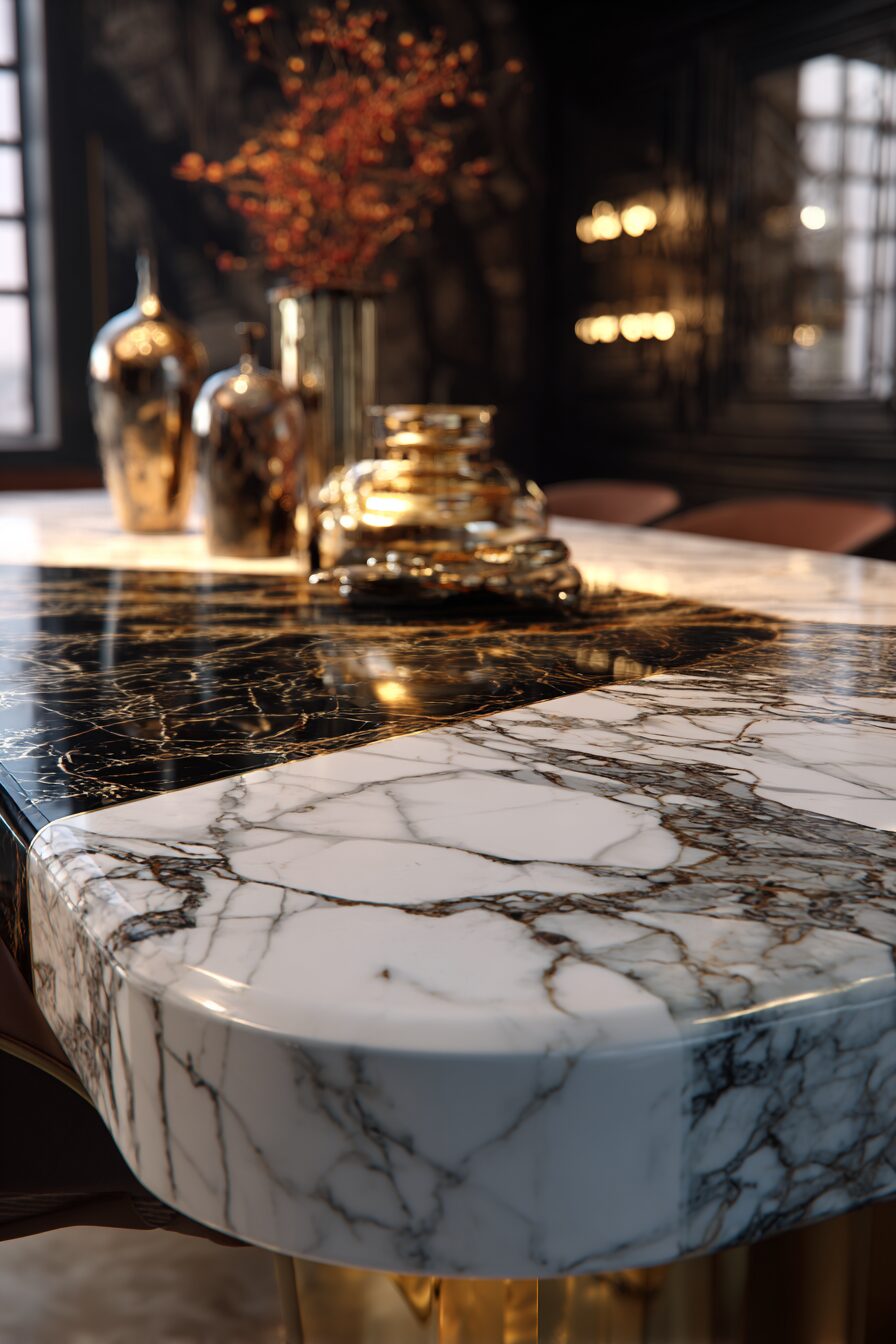Marble dining tables aren’t just furniture – they’re conversation starters that transform your dining room into a sophisticated masterpiece.
If you’re hosting intimate dinners or grand celebrations, the right marble table becomes the stunning centerpiece that elevates every meal into an unforgettable experience.
Waterfall Edge Marvel: The Showstopper That Defies Gravity
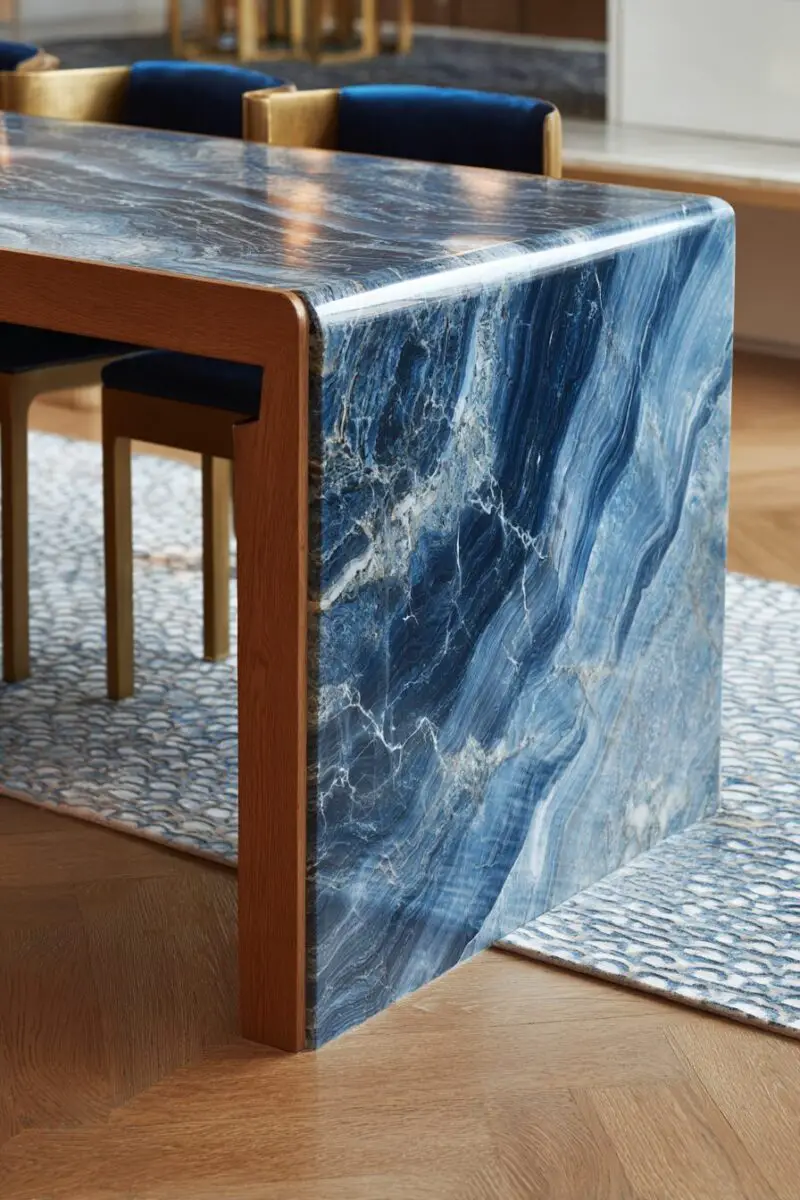
You’ve probably seen those sleek countertops that seem to flow like liquid stone, but imagine that same dramatic effect wrapping around your dining table.
The waterfall edge marble dining table creates an optical illusion that makes the stone appear to cascade seamlessly from the tabletop down to the floor.
This design works particularly well with book-matched marble slabs, where the veining patterns mirror each other perfectly on both sides.
You’ll find that Calacatta or Statuario marble works best for this style because their bold, dramatic veining creates stunning visual continuity as it flows over the edge.
The thickness of the marble slab becomes crucial here – you want at least 3 inches to achieve that substantial, luxurious look that makes guests do a double-take.
Installation requires expert craftsmanship since the corner where the top meets the side needs to be perfectly mitered at a 45-degree angle.
You can choose between a single waterfall edge for a more subtle effect or go bold with waterfall edges on both ends for maximum drama.
The base structure underneath needs to be carefully engineered to support the weight while remaining completely hidden from view.
This design particularly shines in modern and contemporary settings where clean lines and minimalist aesthetics reign supreme.
You’ll appreciate how the waterfall edge eliminates the need for decorative table legs, creating an uninterrupted flow that makes your dining space feel larger and more open.
Maintenance becomes easier too since there are fewer crevices for dust and debris to accumulate compared to traditional pedestal or leg designs.
The investment is significant, but you’re essentially getting a piece of functional sculpture that serves as both dining surface and artistic statement.
When you pair this design with the right lighting – think pendant lights that highlight the marble’s natural veining – you create a dining experience that feels more like fine dining at a five-star restaurant than eating at home.
Madison’s Current Obsessions
Which Dining Table Color Works Best with Your Dark Hardwood? 11+ Stunning IdeasLive Edge Fusion: Where Raw Nature Meets Refined Elegance
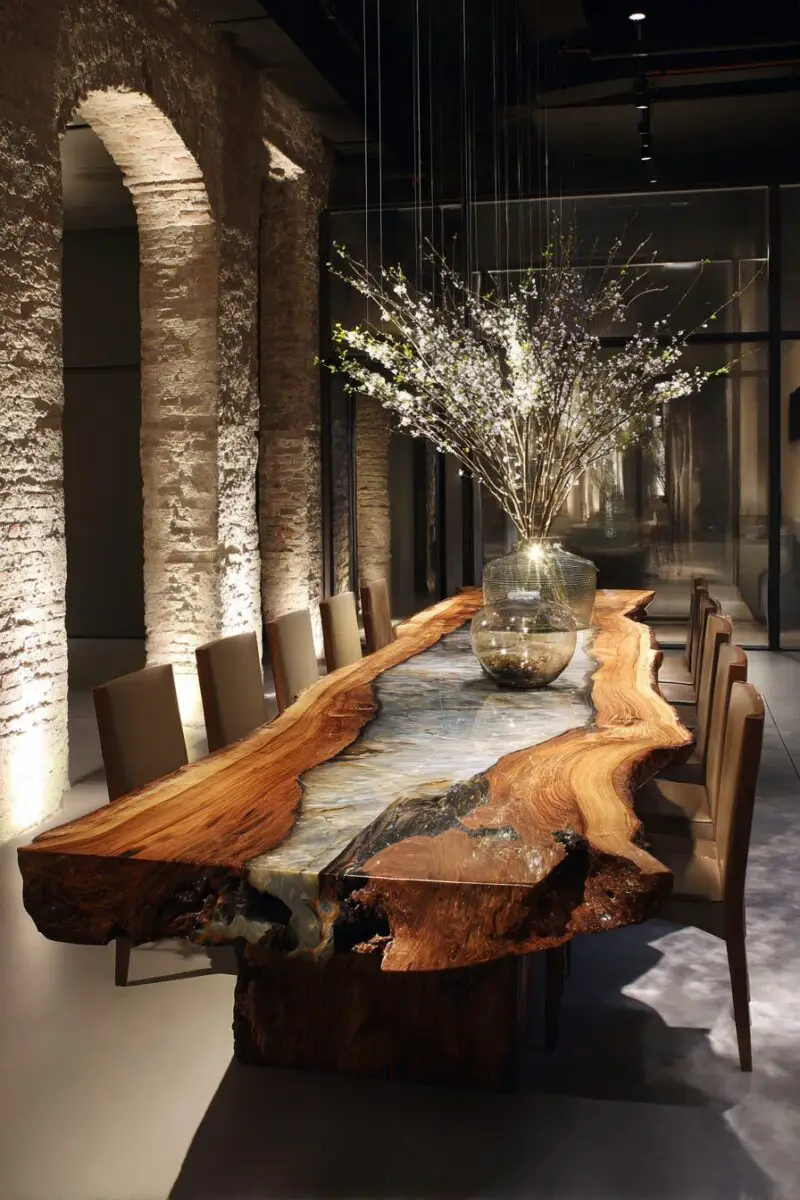
You might think marble and raw wood edges don’t belong together, but this unexpected combination creates one of the most striking dining table designs you’ll ever encounter.
The live edge marble fusion table takes a slab of marble and incorporates the natural, unfinished edge of the original stone block, creating an organic contrast against the polished surface.
This design celebrates the stone’s natural formation while maintaining the sophistication you expect from marble furniture.
You can opt for a partially live edge design where only one side maintains its natural form, or go completely wild with live edges on multiple sides.
The key is finding marble slabs that have interesting natural edges – something that looks intentional rather than simply unfinished.
Carrara marble works exceptionally well for this style because its subtle veining complements rather than competes with the dramatic edge treatment.
You’ll need to work with a stone fabricator who understands how to preserve and enhance the natural edge while ensuring the rest of the surface meets dining table standards.
The contrast between the smooth, polished dining surface and the rough, natural edge creates a tactile experience that guests can’t resist touching.
This design philosophy extends beyond just the marble – you can incorporate live edge wood elements as accent pieces or even as part of the base structure.
The organic nature of this design makes it perfect for transitional spaces that blend modern sophistication with rustic charm.
You’ll find that this style works particularly well in homes with exposed brick, reclaimed wood accents, or other natural materials that echo the live edge aesthetic.
The uniqueness factor is off the charts since no two live edge marble pieces will ever be identical – you’re essentially getting a one-of-a-kind dining table.
Lighting plays a crucial role in showcasing this design, as side lighting can emphasize the texture and depth of the live edge while highlighting the marble’s natural patterns.
The maintenance is straightforward for the polished areas, but the live edge requires special attention to prevent moisture damage and preserve its natural beauty.
Design Your Dream Room in Minutes!
🏡 Start Creating FREE →Madison’s Current Obsessions
13 SMALL Living Room/Dining Room Combo IdeasRound Pedestal Perfection: The Timeless Design That Never Goes Out of Style
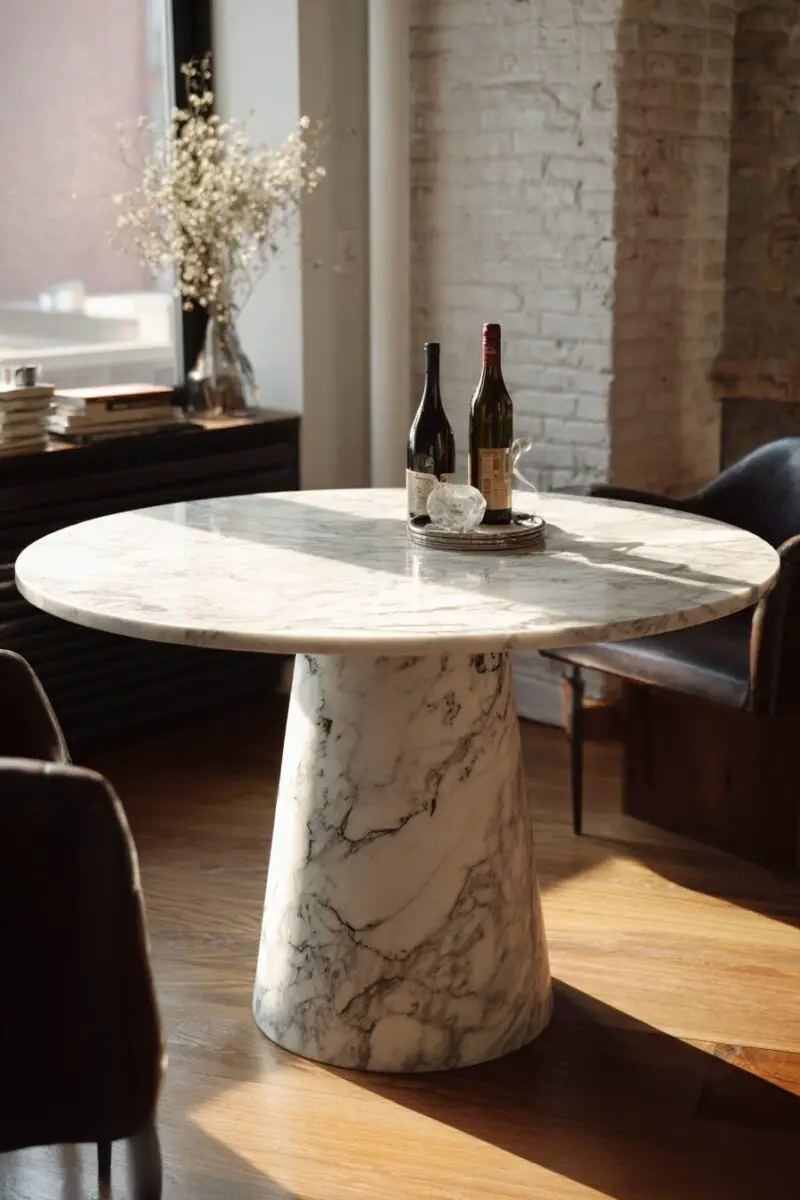
You can’t go wrong with a round marble pedestal dining table – it’s the design equivalent of a little black dress, always appropriate and eternally elegant.
The circular shape promotes conversation and creates an intimate dining experience where everyone feels equally included in the gathering.
The single pedestal base maximizes legroom and eliminates the awkward corner seats that can make rectangular tables feel cramped.
You have incredible flexibility with marble selection here, from the classic white Carrara with its subtle gray veining to the dramatic black Marquina with its bold white strikes.
The pedestal base itself becomes a design opportunity – you can choose from turned wood, polished metal, carved stone, or even a sculptural concrete base.
Proportion is everything with this design; the tabletop diameter should be substantial enough to feel generous but not so large that conversation becomes difficult across the table.
You’ll find that a 54-inch diameter comfortably seats six people, while a 60-inch table can accommodate eight for special occasions.
The thickness of the marble top affects both the visual weight and the overall proportions – a thicker top creates a more substantial, luxurious feeling.
This design works brilliantly in both formal dining rooms and casual breakfast nooks, adapting to your space’s personality through styling and accessories.
You can enhance the classic appeal with traditional dining chairs or completely modernize the look with contemporary seating that creates an interesting style juxtaposition.
The round shape makes this table incredibly versatile for different occasions – intimate dinners feel cozy while larger gatherings maintain that sense of togetherness.
Maintenance is simpler than you might expect since the smooth, continuous surface has no corners or crevices where crumbs can hide.
The pedestal base design also makes cleaning underneath effortless, which is particularly important in dining areas that see frequent use.
You’ll appreciate how this timeless design serves as a neutral foundation that allows your table settings, centerpieces, and seasonal decorations to take center stage without competing with an overly dramatic table design.
Madison’s Current Obsessions
Stylish Living/Dining Room Combo Ideas You'll LoveGeometric Base Artistry: Where Mathematics Meets Marble Magic
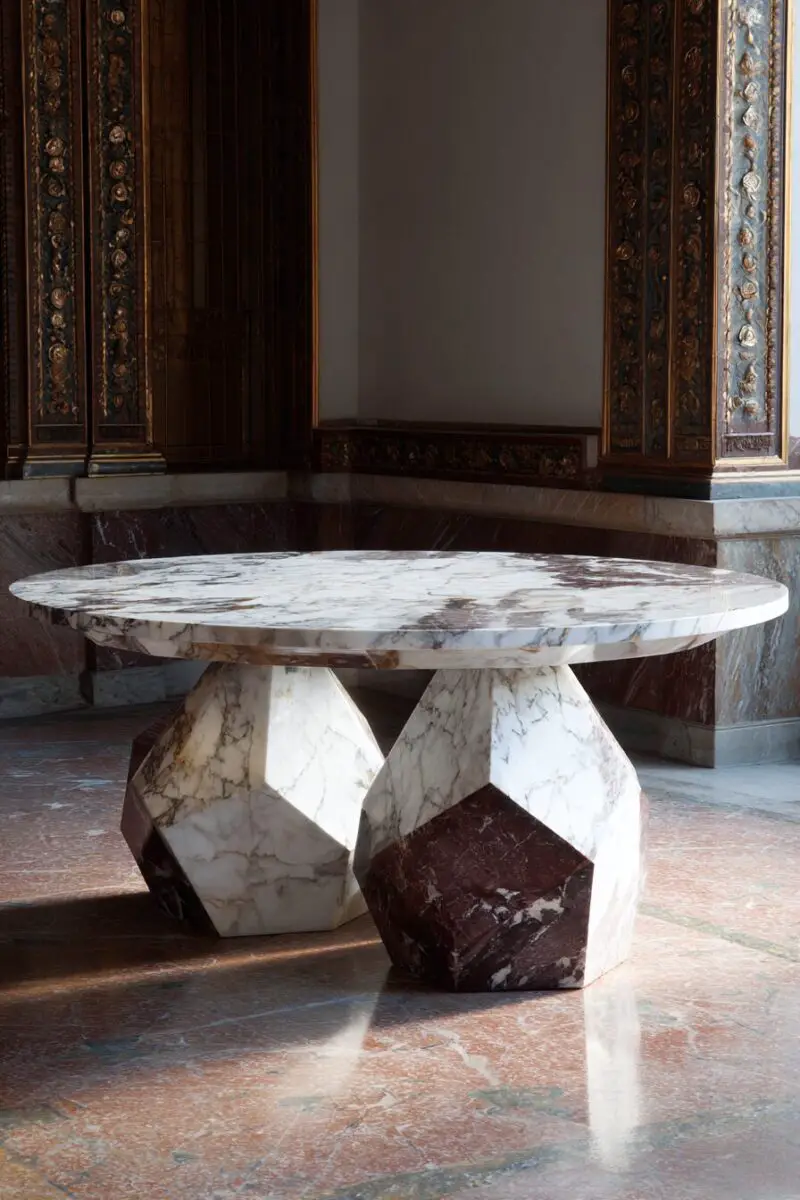
You’re looking at the future of dining table design when you consider a marble top supported by a geometric base that looks like it belongs in a modern art museum.
These angular, sculptural bases transform the humble dining table into a conversation piece that guests will photograph and remember long after dinner ends.
The geometric base can take countless forms – think hexagonal structures, interlocking triangles, or even complex polyhedrons that seem to defy the laws of physics.
You have the option to create contrast by pairing a heavily veined marble top with a clean, minimalist geometric base, or go for harmony by echoing the marble’s patterns in the base design.
Metal bases work particularly well for this style, with options ranging from brushed brass for warmth to blackened steel for industrial appeal.
The engineering behind these designs is fascinating – the geometric shapes aren’t just for show, they’re carefully calculated to distribute the marble’s weight evenly while creating visual lightness.
You can choose between bases that touch the floor at multiple points for stability or cantilever designs that appear to float the marble top in mid-air.
The scale of the geometric elements matters tremendously; oversized geometric shapes create bold statements while smaller, more intricate patterns offer subtle sophistication.
This design philosophy works exceptionally well with book-matched marble where the mirrored veining patterns complement the mathematical precision of the base.
You’ll find that lighting becomes even more important with geometric bases since the angular shapes create interesting shadow patterns that change throughout the day.
The beauty of this approach is its adaptability – the same marble top can completely transform its personality simply by changing the geometric base design.
Contemporary homes with clean lines and minimalist aesthetics provide the perfect backdrop for these sculptural dining tables.
You can extend the geometric theme throughout your dining room with coordinating light fixtures, artwork, or even geometric patterns in your table linens.
The contrast between the organic nature of marble and the precise mathematics of geometric design creates a tension that keeps the eye engaged and the mind intrigued.
Madison’s Current Obsessions
13 Calming Japandi Dining Room Ideas With Perfect Color SchemesIndustrial Chic: Marble Meets Metal in Perfect Harmony
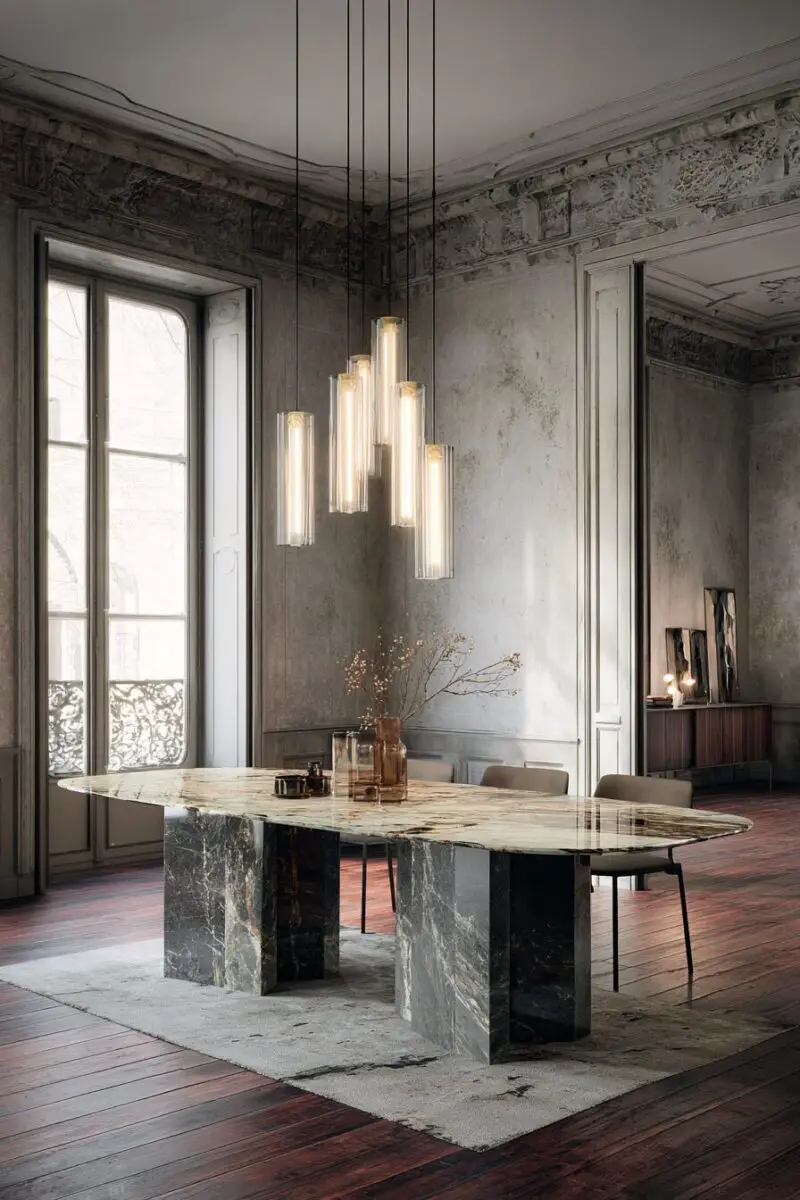
You’ll create an unexpected design statement when you pair the classical elegance of marble with the raw, industrial appeal of metal framework.
This combination brings together two seemingly opposite materials to create a dining table that feels both sophisticated and edgy.
The metal framework can range from delicate hairpin legs that barely interrupt the marble’s visual flow to substantial I-beam structures that make the table feel like industrial architecture.
You can choose between raw steel for an authentic industrial look, powder-coated metal for durability and color options, or even weathered metals that tell a story of age and character.
The key to success with this design lies in getting the proportions right – the metal elements should complement rather than overpower the marble’s natural beauty.
Black marble like Nero Marquina works particularly well with metal bases because it creates a monochromatic palette that feels intentionally designed rather than accidentally assembled.
You have the option to incorporate industrial details like visible bolts, welded joints, or even gear-like mechanisms that celebrate the manufacturing aesthetic.
The contrast in textures becomes a major part of the appeal – the cool smoothness of polished marble against the potentially rough or brushed finish of metal creates a tactile experience.
This style works exceptionally well in loft apartments, converted warehouses, or any space that celebrates the beauty of exposed structural elements.
You can enhance the industrial theme with metal dining chairs, pendant lights with Edison bulbs, or even concrete accents that bridge the gap between materials.
The practical benefits are significant too – metal bases are typically more affordable than carved stone alternatives while offering excellent stability and durability.
Maintenance becomes straightforward since both marble and metal can handle regular cleaning without special requirements.
You’ll appreciate how this design ages gracefully, with any small scratches or patina on the metal adding to the authentic industrial character.
The versatility is remarkable – you can dress up this combination with elegant table settings for formal dinners or embrace the casual side with simple, rustic accessories.
Madison’s Current Obsessions
Create a Cozy Vibe With 13 Log Cabin Dining Room IdeasExtendable Elegance: Marble Tables That Grow With Your Gatherings
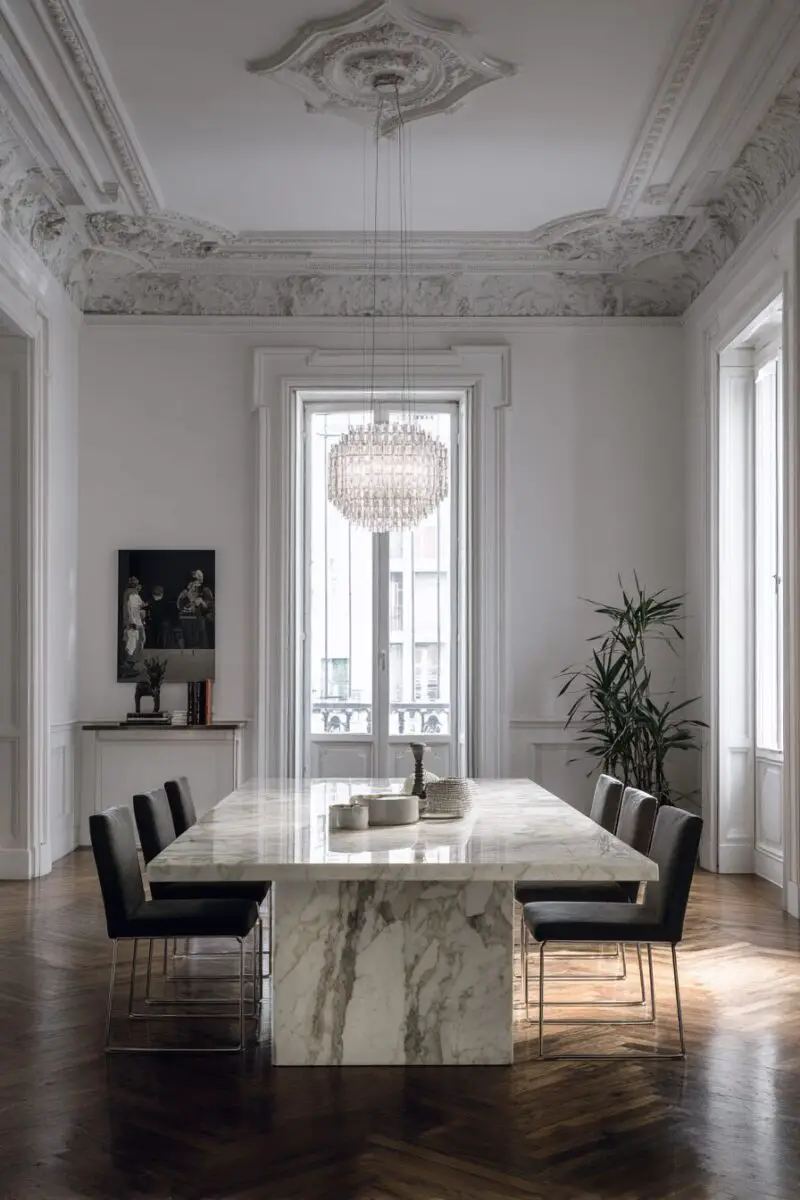
You no longer have to choose between intimate family dinners and large entertaining when you invest in an extendable marble dining table that adapts to your needs.
The engineering challenge of creating an extension mechanism that can handle marble’s weight while maintaining stability has led to some incredibly innovative solutions.
Modern extendable marble tables use sophisticated sliding mechanisms hidden within the base structure, allowing the extension process to feel effortless despite the substantial weight involved.
You can choose between tables that extend with additional marble leaves for a seamless look or mixed-material extensions that create interesting design contrast.
The butterfly leaf mechanism remains hidden when not in use, maintaining the table’s clean lines while providing instant expansion capability when guests arrive.
Some designs incorporate self-storing leaves that slide out from underneath the main surface, eliminating the need for separate storage and making the extension process a one-person operation.
You’ll find that the marble selection becomes even more critical with extendable tables since the grain and veining need to flow naturally across multiple sections.
Book-matched marble works particularly well for this application because the mirrored patterns create visual continuity even when the table is extended.
The base design must be carefully engineered to provide adequate support in both contracted and extended positions while allowing smooth operation of the extension mechanism.
You can opt for tables that extend from seating for six to accommodate ten or even twelve people, making them perfect for holidays and special celebrations.
The quality of the extension hardware makes all the difference – premium mechanisms operate silently and smoothly while maintaining perfect alignment between sections.
Storage considerations become important since you’ll need space for the additional leaves when they’re not attached to the table.
You’ll appreciate the investment value since an extendable table essentially gives you the functionality of multiple furniture pieces in one elegant package.
The design versatility means you can choose a size that fits your everyday space perfectly while knowing you have expansion options for special occasions.
Madison’s Current Obsessions
13 Chic Dining Table Decorations For Every StyleLazy Susan Luxury: Built-In Convenience Meets Marble Sophistication
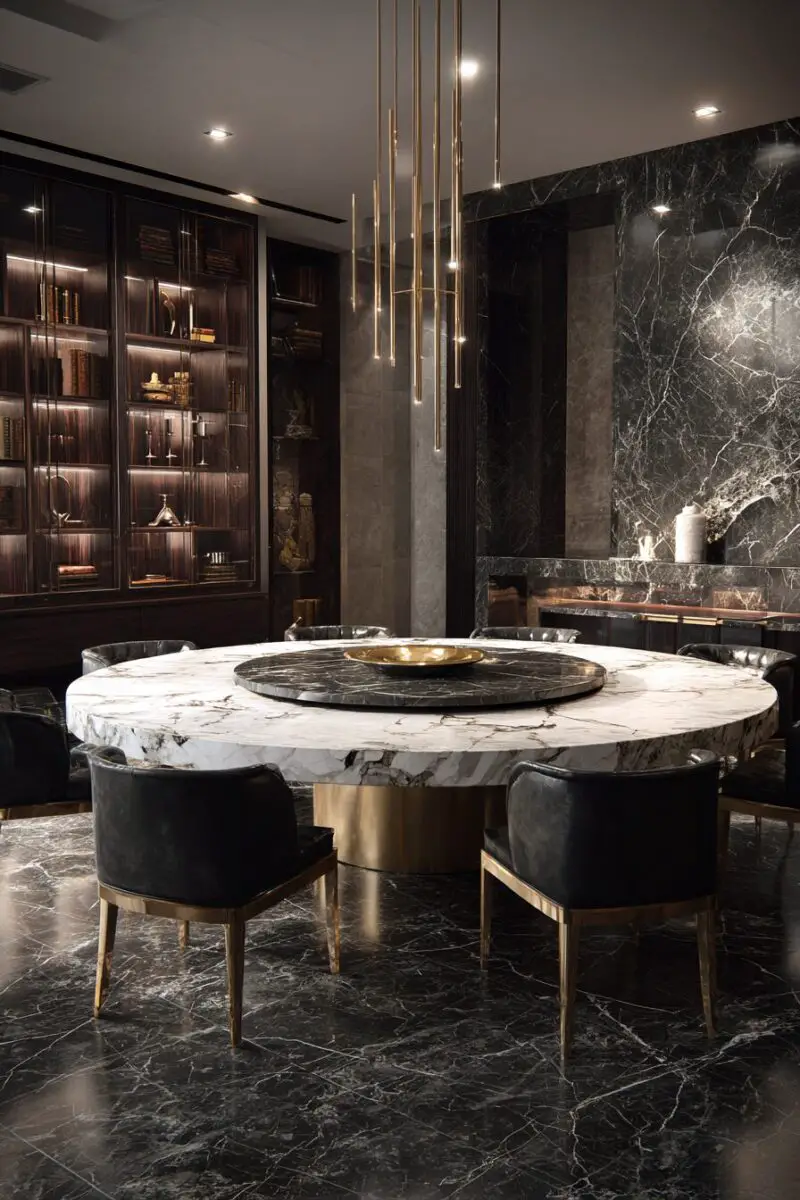
You’re revolutionizing the dining experience when you incorporate a built-in lazy Susan into your marble dining table design.
This isn’t your grandmother’s wooden turntable – modern marble lazy Susan tables integrate the rotating element seamlessly into the overall design aesthetic.
The lazy Susan can be created from contrasting marble to create visual interest or matched to the main table surface for a more unified appearance.
You’ll find that the rotating mechanism needs to be exceptionally smooth and quiet to maintain the sophisticated dining atmosphere you’re creating.
The size of the lazy Susan relative to the overall table becomes a critical design decision – too small and it becomes ineffective, too large and it dominates the visual composition.
Premium ball-bearing systems ensure smooth rotation while supporting the weight of serving dishes, glasses, and centerpieces without wobbling or binding.
You can choose between full-rotation designs that spin 360 degrees continuously or limited-rotation systems that prevent items from spinning off the edge.
The edge treatment where the lazy Susan meets the fixed portion of the table requires careful attention to maintain smooth operation while creating an attractive visual transition.
This design works particularly well for larger round tables where reaching across to share dishes becomes impractical during dinner parties.
You have the option to incorporate the lazy Susan into the table’s center permanently or design it as a removable element that can be lifted out when not needed.
The practical benefits extend beyond just passing dishes – the lazy Susan creates a natural centerpiece platform that can be easily rotated to show different decorative arrangements.
Maintenance requires attention to both the marble surfaces and the mechanical components, but quality systems are designed for years of smooth operation.
You’ll discover that guests are often fascinated by the engineering and craftsmanship required to integrate such functionality into a marble table.
The conversation-starting potential is enormous since this feature combines practical utility with impressive technical execution in a way that few dining table designs can match.
Madison’s Current Obsessions
These Luxe Dining Room Christmas Ideas Are Going ViralTwo-Tone Drama: Creating Visual Interest Through Marble Contrast
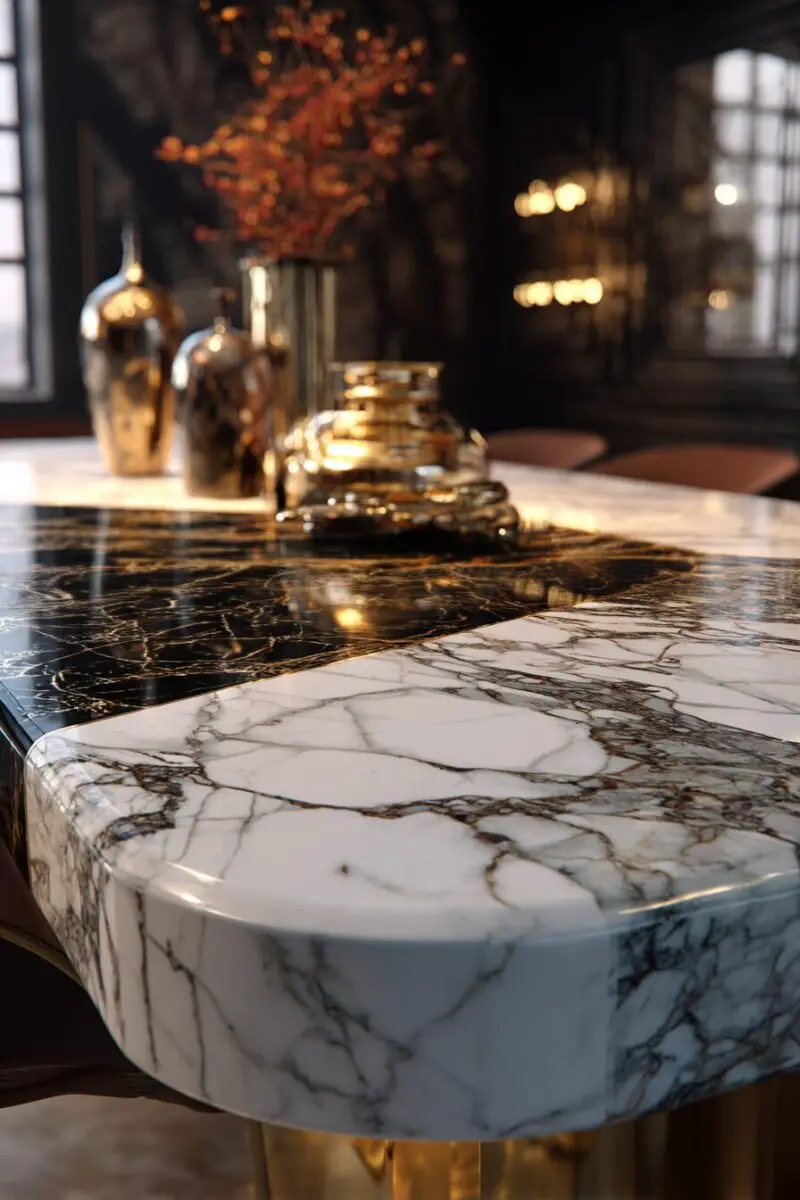
You can achieve stunning visual impact by combining two different marble varieties in a single dining table design that plays with contrast and complement.
The classic approach pairs light and dark marbles – think white Carrara with black Marquina – creating a dramatic statement that works in both traditional and contemporary settings.
You have multiple options for how to incorporate the two marbles: geometric patterns, border treatments, or even gradient transitions that blend from one variety to another.
The most striking designs often use one marble for the main surface and another for accent elements like borders, inlays, or base components.
Checkerboard patterns create a bold, graphic look that transforms your dining table into a oversized game board with sophisticated materials.
You can achieve more subtle contrast by pairing marbles with similar base colors but different veining patterns, creating depth without overwhelming drama.
The technical challenge lies in ensuring that both marble varieties have similar hardness and expansion characteristics to prevent cracking or separation over time.
Book-matching techniques become even more complex when working with two marble types, requiring careful planning to achieve balanced, symmetrical patterns.
You’ll find that the cutting and installation require master craftsmen who understand how to work with multiple stone varieties while maintaining perfect alignment and smooth transitions.
The color theory behind successful two-tone combinations goes beyond just light and dark – consider undertones, vein colors, and how the marbles will interact under different lighting conditions.
This design approach works particularly well in spaces that already incorporate multiple materials or color schemes, allowing the table to bridge different design elements.
You can extend the two-tone concept to other elements in the room, using the same marble combinations for backsplashes, countertops, or decorative accents.
The maintenance requirements may vary between the two marble types, so understanding the care needs for each variety ensures your table maintains its beauty over time.
The investment in a two-tone marble table often exceeds single-marble designs, but the visual impact and uniqueness factor justify the additional cost for discerning homeowners.
Madison’s Current Obsessions
Everyone Who Loves Cozy Winters Is Trying These CenterpiecesIntegrated Bench Seating: Marble Tables That Redefine Dining Comfort
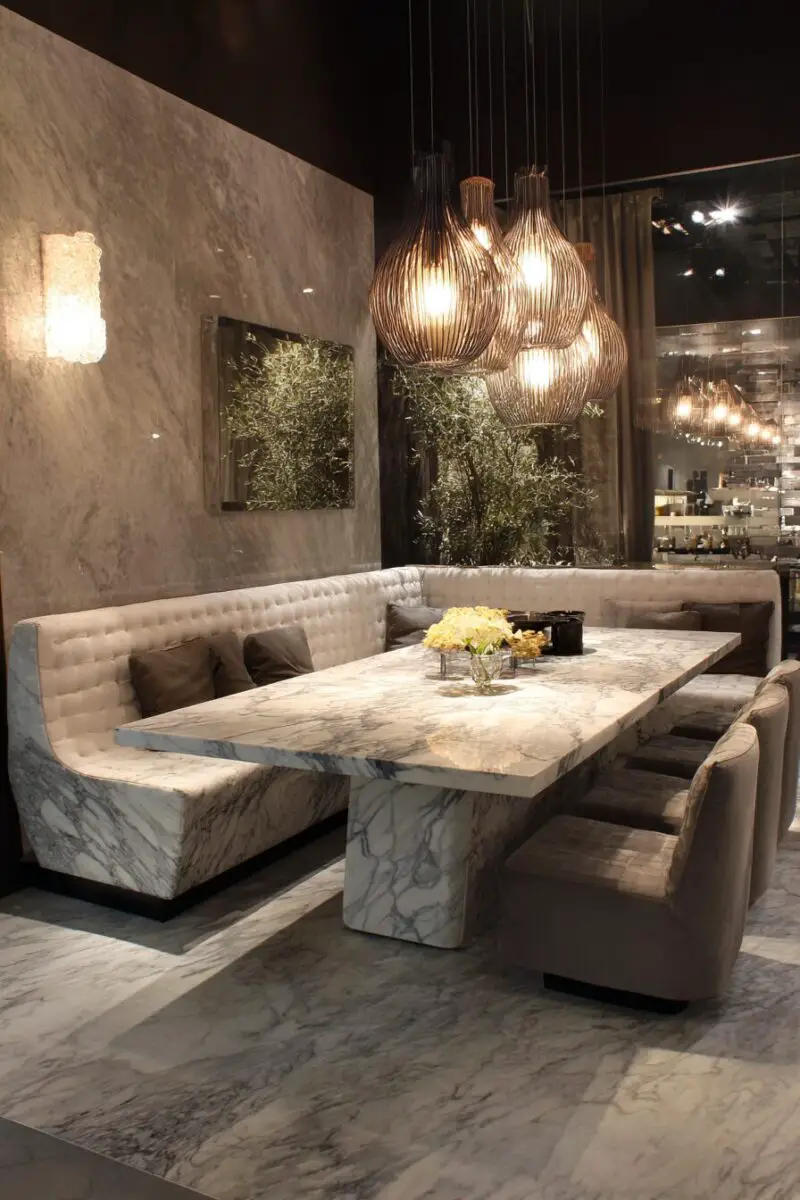
You’re looking at the future of space-efficient dining when you consider marble tables with integrated bench seating that maximizes both style and functionality.
The seamless connection between table and seating creates a unified furniture piece that appears to be carved from a single, massive block of stone.
This design eliminates the visual clutter of separate chairs while providing comfortable seating that can accommodate more people in less space.
You can choose between U-shaped configurations that wrap around three sides of the table or simple bench seating along one or both long sides.
The engineering challenge involves creating comfortable seating height while maintaining proper table proportions – typically requiring careful attention to ergonomic measurements.
Cushioning becomes essential for comfort, and you’ll want to select materials that complement the marble while providing adequate padding for extended dining sessions.
The storage potential underneath bench seating adds practical value, allowing you to hide table linens, serving pieces, or seasonal decorations.
You have the option to incorporate backrests into the bench design or keep them backless for a cleaner, more minimalist appearance.
The marble selection needs to consider both the table surface and the seating areas since they’ll be subject to different types of wear and potential staining.
This design works exceptionally well in breakfast nooks, kitchen islands, or any space where maximizing seating capacity within limited square footage is important.
You can create visual separation between the table and bench areas through different marble finishes – perhaps polished for the table surface and honed for the seating areas.
The installation complexity increases significantly since the entire piece needs to be perfectly level and properly supported to prevent cracking or settling.
You’ll appreciate how this design eliminates the constant chair rearranging that comes with traditional dining sets while creating a more intimate, communal dining experience.
The modern aesthetic works particularly well in contemporary homes where clean lines and efficient use of space align with overall design philosophy.
Madison’s Current Obsessions
13 Cozy Vintage Dining Room Inspirations That Feels Like HomeFloating Marvel: Suspended Marble Tables That Defy Expectations
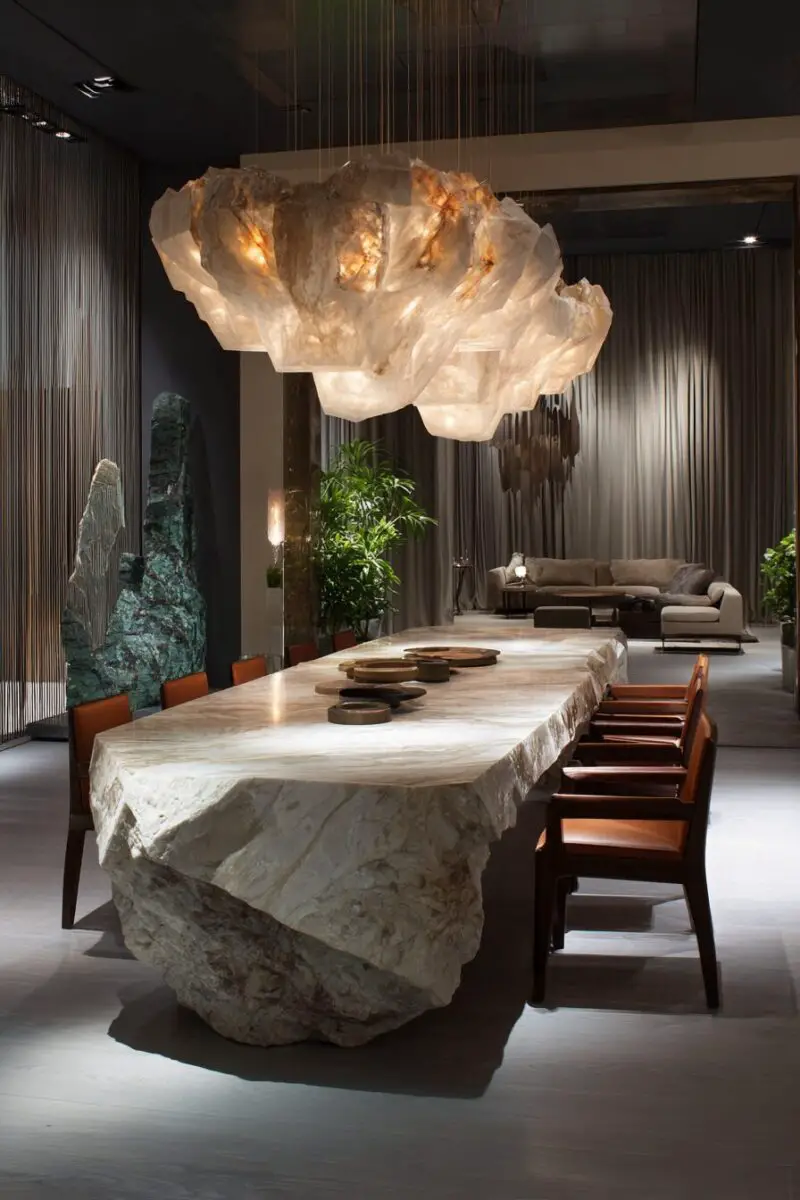
You’ll create the ultimate conversation piece with a floating marble dining table that appears to levitate above the floor through clever engineering and optical illusion.
The magic lies in virtually invisible support systems – whether it’s ultra-thin steel cables from the ceiling, transparent acrylic supports, or cleverly concealed cantilever mechanisms.
This design pushes the boundaries of what’s possible with marble furniture while creating a dining experience that feels almost otherworldly.
You need to work with structural engineers to ensure that your ceiling or wall can handle the significant weight of marble plus the dining load.
The visual impact is tremendous since guests’ eyes naturally search for supports that appear to be missing, creating a sense of wonder and curiosity.
Cable suspension systems can be nearly invisible when properly executed, using high-strength aircraft cables that virtually disappear against the right background.
You have the option to embrace the suspension system as part of the design aesthetic or work to make it as invisible as possible for maximum floating effect.
The marble selection becomes crucial since book-matched slabs with dramatic veining can enhance the floating illusion by creating visual continuity that draws attention away from support points.
This design requires perfect balance and weight distribution, often necessitating custom engineering for each specific installation and space.
You’ll find that lighting plays an enormous role in selling the floating illusion – proper uplighting can eliminate shadows that might reveal support mechanisms.
The maintenance and inspection requirements are more complex than traditional tables since the support systems need regular checking to ensure safety and stability.
This approach works best in spaces with high ceilings and minimalist aesthetics where the floating table can be the undisputed focal point.
You can enhance the floating effect with coordinating design elements like floating shelves, suspended light fixtures, or other elements that reinforce the gravity-defying theme.
The investment is substantial due to the custom engineering and installation requirements, but the result is a truly unique dining experience that guests will never forget.
These stunning marble dining table designs prove that functional furniture can be breathtaking art that transforms your dining space into something extraordinary.

